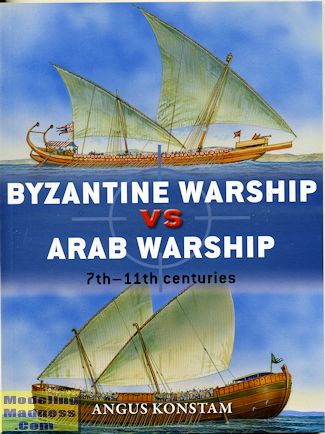 One thing
about Osprey's Duel series is that it covers a considerable amount of historical
ground. Such is this edition that runs from the 7th to the 11th century. During
this time period, the most prominent power in the world was Byzantium, though a
bit later on, the Arab world of North Africa started to make itself felt. In
fact, it was from the middle to the end of this period when there were a
considerable number of clashes between the two, both on land and at sea.
One thing
about Osprey's Duel series is that it covers a considerable amount of historical
ground. Such is this edition that runs from the 7th to the 11th century. During
this time period, the most prominent power in the world was Byzantium, though a
bit later on, the Arab world of North Africa started to make itself felt. In
fact, it was from the middle to the end of this period when there were a
considerable number of clashes between the two, both on land and at sea.
The Byzantines based their ship building on what had come
before and that was the Greeks and the Romans. During these ages, nautical
technology, such as it was, moved slowly. As a result, Byzantine warships were
still man powered, though there was a sail for fairly long voyages. Fairly long
meant a few days as these ships were not designed for long journeys, having not
the room for provisions or a lot of water. When you have a hundred or more men
pulling oars, you go through a great deal of water. More often than not, these
boats would travel fairly close to the coast where they could easily take on
provisions.
Byzantine ships had a major design difference over those that
came before and that is that the ram was now above the waterline. This still
acted in the same manner as before, but was less likely to actually sink the
enemy ship, enabling it to be captured in a more intact state. The Byzantines
also had a major advantage over the Arab vessels and this is what we now call
'Greek Fire'. By all accounts, this acted very much like napalm. It was heated
in a metal boiler until it built up pressure. It was then forced through piping
at a high pressure and the liquid was ignited by a flame at the nozzle of a
movable 'gun' of sorts. The result was the ability to force this flame out to a
reasonable distance. This weapon allowed the Byzantines to maintain ascendency
on the seas for a considerable amount of time.
Naturally, things do not remain the same and the Arabs got
their hands on the technology either through a spy, deserter or other means.
Arab ships were similar to those of the other side, but did not have a ram, were
generally a bit wider and were heavier boats. Both sides made great use of
archers and until the deployment of Greek Fire this was the main way that either
side attacked each other at range. There were platforms fore, aft and amidships
for archers. Rowers were also expected to take part in battle once the ships
were side by side.
In fact, prior to battle, the sails were taken down and it
was rowing power that moved the ships. Byzantine ships were generally faster,
able to make 10 knots for as long as the rowers could hold speed. They could
rarely sail much faster than 4-6 knots top. Though designed a bit differently,
and with designs slowly changing over time, the two sides were remarkably equal.
The author does a super job of covering the design and
operation of both sides, especially when one considers the dearth of information
that has been passed down. Few authors wrote about the battles in any detail and
what few illustrations we have are revealing but not very accurate. Especially
interesting is the discussion on how the ships were built, going from a sturdy
construction to one a bit more flexible to allow it to handle the seas better. I
have to admit that I got a bit confused with the various terms that were used at
first, though by the end of the book I had a better idea of what was what.
It all makes for another superb edition in Osprey's Duel
series. I can easily see how this has become such a popular series and this is
one good reason why. Highly recommended.
September 2015
For more on the complete line of Osprey books,
visit http://ospreygrp.com. In the US, it is
Osprey Direct at 443 Park Avenue South, New York, NY 10016, where you can
get a catalogue of available books.
If you would like your product reviewed fairly and quickly, please contact
me or see other details in the Note to
Contributors.
 One thing
about Osprey's Duel series is that it covers a considerable amount of historical
ground. Such is this edition that runs from the 7th to the 11th century. During
this time period, the most prominent power in the world was Byzantium, though a
bit later on, the Arab world of North Africa started to make itself felt. In
fact, it was from the middle to the end of this period when there were a
considerable number of clashes between the two, both on land and at sea.
One thing
about Osprey's Duel series is that it covers a considerable amount of historical
ground. Such is this edition that runs from the 7th to the 11th century. During
this time period, the most prominent power in the world was Byzantium, though a
bit later on, the Arab world of North Africa started to make itself felt. In
fact, it was from the middle to the end of this period when there were a
considerable number of clashes between the two, both on land and at sea.